Crinum lugardiae
Crinum lugardiae N.E.Br.
Family: Amaryllidaceae
Common names: veld swamplily, Lugard's crinum (Eng.); veldlelie (Afr.)
Introduction
Crinum lugardiae has a rosette of strap-shaped leaves, fragrant, bell-shaped white flowers with long thin floral tubes, in early summer, followed by strongly beaked fruits; it is a small crinum, and the one to choose for small gardens where there is not enough space for the robust Crinum macowanii.
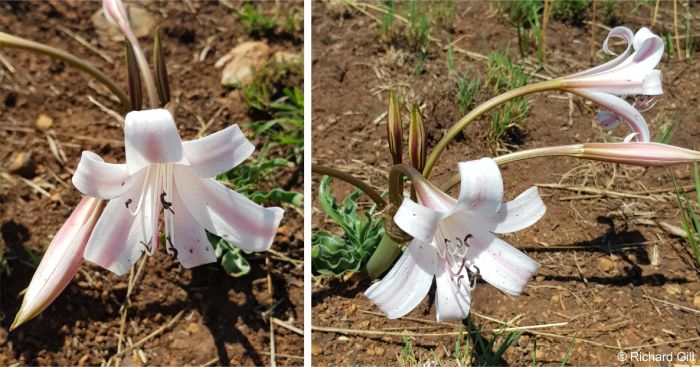
Description
Description
Crinum lugardiae is a deciduous, summer-growing bulbous plant, 280–350 mm tall. The bulb is globose, 40–70 mm in diameter, single, with a distinct neck 40–120 mm long, clothed in many layers of dark brown, cartilaginous outer tunics. The leaves are arranged in a rosette, and are narrowly strap-shaped, measuring 290–400 mm in length and 8–30 mm in width. They are spreading or arching, leathery, deeply channelled, bright green or greyish-green (glaucous) and they occur at the same time as the flowers. The margins are flat or mildly to moderately undulate, ciliate and narrowly cartilaginous.
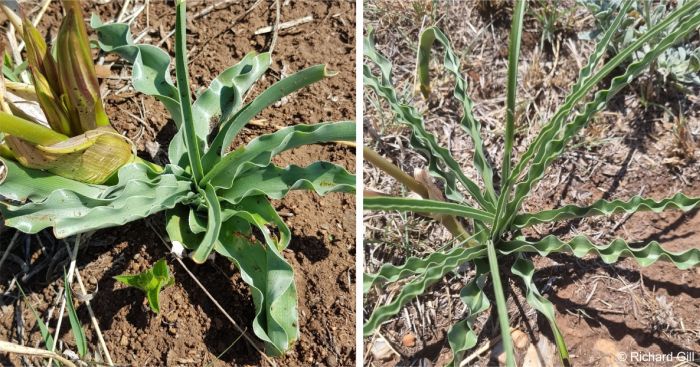
The inflorescence is an umbel of eight to thirteen flowers, the peduncle is erect to suberect, slender, 150–300 mm in length; the spathe bracts are lanceolate, spreading and measure 45-110 mm in length by 10–25 mm in width. The pedicels are light green, erect and vary in length from 5–20 mm. The flowers are zygomorphic, bell-shaped, drooping, sweet-scented, and have a slender, light green perianth tube that is 80–130 mm long and gently to strongly curved. The tepals are oblanceolate, 70–90 mm long and 15–20 mm wide, overlapping, and white with a pink median stripe on the outer surface. The tips of the tepals are strongly recurved. The stamens, are declinate (bent or curved downward), white, gradually turning pink at the apex, the anthers are black, the pollen is white. The style is rose pink, the stigma is tiny and pink.
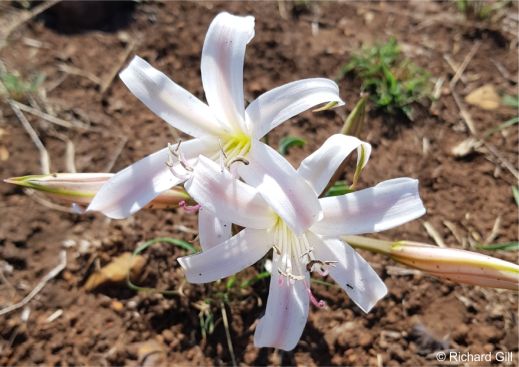
The fruit is a capsule, globose, bright green, sharply beaked, and about 30 mm in width. The seeds are globe-shaped, light green, with a diameter of up to 10 mm.
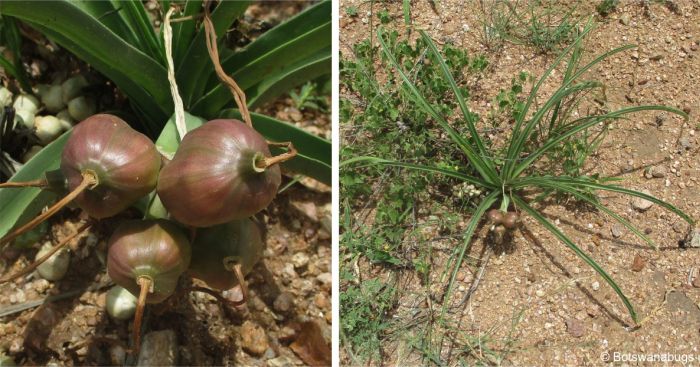
The shape and colour of the flowers, the deeply channelled, glaucous leaves, and the beaked fruits bear resemblance to Crinum macowanii. However, the latter species is much more robust, with wider leaves (more than 40 mm wide) that form a pseudostem and are basally sheathed. It also has broader penduncles, non-ciliate leaf margins, larger flowers, fruits and seeds, and black pollen.
Conservation Status
Status
According to the Red List of South African plants, Crinum lugardiae is not threatened and is listed as a species of Least Concern (LC).
Distribution and habitat
Distribution description
Crinum lugardiae occurs in central Namibia, western, northern and eastern Botswana and in South Africa, where it is found in the Northern Cape, North West, Gauteng and Limpopo provinces. It is a gregarious plant that frequently grows in dense colonies and is widespread in and around Gauteng. It tolerates a range of soil types and is typically found on open flats with low green cover and seasonally moist heavy clay. With the development of leaves in spring and early summer, following the start of rainfall, the plants grow according to a typical summer cycle. When the leaves are fully grown, flowers appear and soon after, quickly ripening fruits follow. In the winter, the bulbs are entirely dormant.
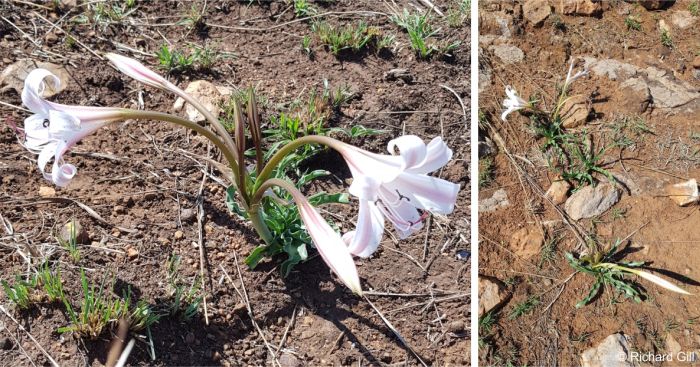
Derivation of name and historical aspects
History
The genus name Crinum is a Greek word krinon, that means ‘lily’. This species is named after Charlotte Eleanor Lugard-Howard (1859–1939), who was a professional painter and plant collector. She was married to Major Edward James Lugard and they both collected extensively in Botswana. In around 1896-1897, Charlotte collected this bulb in Ngamiland at Kwebe Hills near Lake Ngami in north-west Botswana. She then submitted the bulb to Kew, where it flowered. N.E. Brown designated the herbarium specimen that Charlotte collected as the type material.
The genus Crinum is distributed in Africa, Australia, Asia and America. It has between 60 and 100 species. The uncertainty with the total number of species is because crinums are difficult to assess from dried herbarium specimens, thus the taxonomic challenges. There are 14 species recognised in South Africa, where they are widespread in the summer-rainfall region.
Ecology
Ecology
Crinum lugardiae is well adapted to a summer-rainfall climate, where there is sometimes frost in winter. For them to survive cold winter conditions and frost, their leaves die back and the bulb remains dormant throughout winter. Come spring, they resprout again, even when there is no rain.
Uses
Use
Crinum lugardiae has a lot of horticultural potential, just like its sister plant, the popular Crinum macowani. It can be planted in a bulb or geophyte garden, or in a bed that is well-watered in summer but dry in winter, and it also has potential in the cut flower industry. Crinum species have been used to treat various ailments even though they have been scientifically proven to be poisonous. The bulbs contain toxic alkaloids, and should be used with caution. Poisonous plants have been used in traditional medicine for generations in South Africa and traditional healers know just the right dosages.

Growing Crinum lugardiae
Grow
Crinums are generally easy to cultivate. C. lugardiae does well in a pot, as well as in the ground. In both situations, plant the bulb with the top of the neck just below the level of the soil. Plant in deep 30 cm diameter pots, filled with sandy soil mixed with compost. Place the pot in a position where the plant will receive morning sun or enough bright light throughout the day. Water heavily in summer at well-spaced intervals, and keep the bulb dry in winter when they are dormant.
The bulbs are solitary, thus the best way to propagate is by seed. The seed has a high moisture content which enables it to germinate easily, even during dry conditions. This also means they are not suitable for long term storage. The seeds germinate quickly, thus is it best to sow them as soon as they ripen.
Sow the seeds in a deep seedling tray filled with sandy soil mixed with compost. Keep the roots undisturbed and they may flower in their third year. Common pests that damage crinums are snails, slugs and lilly borers. Here in the Walter Sisulu National Botanical Garden, the koppie foam grasshoppers eat the flowers.
References
- Archer, R.H. 2004-09. Crinum L. (Amaryllidaceae). PlantZAfrica. Online. https://pza.sanbi.org/crinum.
- Botswanabugs. 2021-01. Observation of Crinum lugardiae, Botswana. iNaturalist. Online. https://www.inaturalist.org/observations/88370034.
- Brown, N.E. 1903. The Gardeners’ Chronicle. Series 3, 34: 49.
- Duncan, G. 2010. Grow bulbs. A guide to the cultivation of bulbs of South Africa and neighbouring countries. Kirstenbosch Gardening Series. South African National Biodiversity Institute, Cape Town.
- Duncan, G., Jeppe, B. & Voigt, L. 2016. The Amaryllidaceae of southern Africa. Umdaus Press, Pretoria.
- Gill, R. 2024. Observations of Crinum lugardiae. iNaturalist. Online. https://www.inaturalist.org/observations?taxon_id=367443&user_id=richardgill.
- Glen, H.F. & Germishuizen, G. (compilers). 2010. Botanical exploration of southern Africa, edition 2. Strelitzia 26. South African National Biodiversity Institute, Pretoria.
- Notten, A. 2013. Crinum macowanii Baker (Amaryllidaceae). PlantZAfrica. Online. https://pza.sanbi.org/crinum-macowanii.
- Raimondo, D., Von Staden, L., Foden, W., Victor, J.E., Helme, N.A., Turner, R.C., Kamundi, D.A. & Manyama, P.A. (eds) 2009. Red list of South African plants. Strelitzia 25. South African National Biodiversity Institute, Pretoria.
- Verdoorn, I.C. 1973. The genus Crinum in southern Africa. Bothalia 11 (1&2): 27–52.
Credits
Linda Booysen and Dineo Dibakwane
Walter Sisulu National Botanical Garden
December 2024.
Acknowledgements: the authors thank Richard Gill and Botswanabugs for making their images available on iNaturalist and Geoff Nichols for the images of Crinum lugardiae in cultivation.
Plant Attributes:
Plant Type: Bulb
SA Distribution: Gauteng, Limpopo, North West, Northern Cape
Soil type: Sandy, Clay, Loam
Flowering season: Early Summer
PH: Acid, Neutral
Flower colour: White, Pink
Aspect: Full Sun
Gardening skill: Easy
Special Features:
Horticultural zones









Rate this article
Article well written and informative
Rate this plant
Is this an interesting plant?
Login to add your Comment
Back to topNot registered yet? Click here to register.